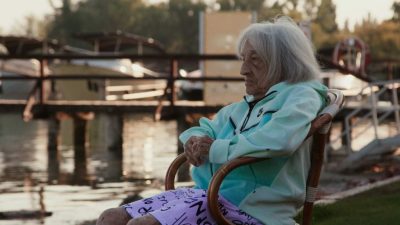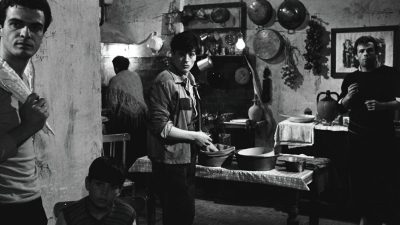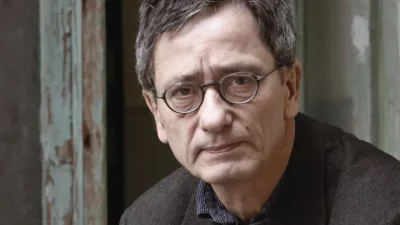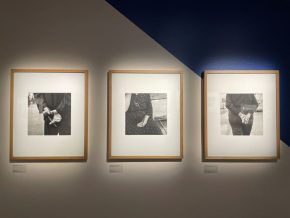“I bumped into BIG! He asked about you, too…”
So many times I have heard this sentence from my grandpa, and so many times I have heard him telling me his news about István Gábor Benedek, nicknamed BIG, the old, wise writer and journalist, who also became something like a faraway mentor to me through my grandpa’s acquaintance. He even came to my book launch. Then, around a month ago, the horrible news struck me that I won’t be able to meet him anymore: István Gábor Benedek died shortly before his 85th birthday.
Nevertheless, our joint (what a word!) story hasn’t ended with that yet. Not long after the news of his passing, I received a book which was, to my great astonishment, a BIG short story collection – in English. Bergen Waltz is the translation of a Hungarian volume (Bergeni keringő), with some slight changes. One of the Hungarian stories didn’t make it to the English version, but a signature story of the author’s, The Torah Scroll of Tótkomlós, was added to the end instead. This one, which even loaned its title to another Hungarian collection, is such a strong essence of BIG’s storytelling and worldview that I understood why the editors didn’t want to miss it out. Even more if we consider that, although these are all separate pieces put together, it is still not irrelevant how a book ends. Indeed, the last words of The Torah Scroll of Tótkomlós might strike the reader even more than those of the original ending piece (titled Pompadour).
The stories of István Gábor Benedek are shreds of memories. Even though he wrote them piece by piece, we can interpret them as a novel together. Novel of the pre-second-world-war village Tótkomlós in South-Eastern Hungary, where the always-in-the-know community members whisper gossip in the Benedek parents’ ears, then they in their son’s, and now he in ours. We can learn who Black Stevie is – a cosmopolitan handmaid’s illegitimate child –, or local photographer Kóbi Weisz whose famous artist brother even painted a portrait of Miklós Horthy de Nagybánya (leader of Hungary between the two world wars who allied with the Nazis). The first few stories start lightly: the author comes up with anecdotes of sweet humour and a lot of self-irony, recollecting stories of such admirably clumsy people. But then all storylines get to what happened – at those times. And like many of his generation, BIG initially falls silent about the details of the Shoah. Once he even states that he won’t talk about Bergen-Belsen, and continues with something else.
But he collects his strength from story to story, the deterrent force of trauma gets weaker and weaker, and suddenly the Bergen-Belsen experiences burst out of BIG. And here we are again, at the complete borderlines of literary expressive power, where we have been before and which gave Imre kertész a Nobel Prize. Whatever! We need to read once more and once more and once more and once more, this time from this particular writer, how it is to starve, to have worms and typhus, to freeze, to be so viscerally afraid that it deprives one from all sleep.
BIG remembers the others as well: his relatives who were with him in the camp, the girl who tried to organise a children’s group, the German officers, the prisoners of war, the kapos, and the man who taught him to read in the middle of hell. Indeed, all captives knew that keeping your intellectual interests will let you stay human, no matter how hard they try to prove to you that you are not one. It is another question, though, how likely this was in a situation where acts of “humanity” were on the edge of impossibility physically and mentally. Therefore, in BIG’s book, we hear about people blackmailing or scamming fellow captives for food, or the children’s group that bullied a little girl for her dialect, or a mother aggressively kicking her own daughter. This was a double struggle: against the Nazi officers and kapos, but also against skeleton-like themselves, let alone their mirror images, fellow skeleton-like people. The goal was not only survival but maintaining human dignity which, I counted, is mentioned at least eight times in the collection.
And then come the scenes of liberation which – as I already noted with other writers who survived the Shoah – suddenly bring an abundance of colours, lights, expressions, and the taste of American chocolate. This was the part when I felt the most that in a private conversation outside of literature, BIG would explain this exactly the same way. And I’m sure he often explained it. He also captures the moment when euphoria is over, and the anxious feeling kicks in: now this is how life needs to go on…
Dear non-Hungarian reader, I warmly recommend you to read Bergen Waltz: it is a great introduction for everyone who has never read South-Eastern Hungarian Jewish stories before. Even myself, who is familiar with BIG’s prose in the original, enjoyed reading his works in another language this time. I lament for the late master but I also find comfort in seeing how his works remain with us, and how they are even available now for the international community.
I thank VINCE BOOKS for the book, and my grandfather László Hacsek for the support provided during the writing of this review.



























Comments